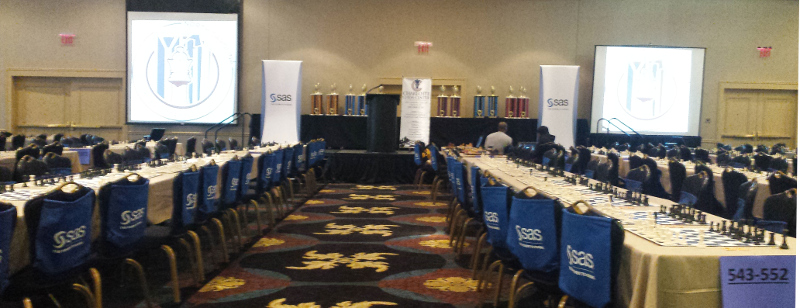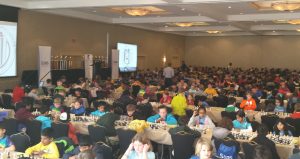 Chess as a team sport? Sure, it’s like singles tennis as a team sport: the team score is an aggregate of individual results.
Chess as a team sport? Sure, it’s like singles tennis as a team sport: the team score is an aggregate of individual results.
Team chess is everywhere from local three-round weekend afternoon chess tournaments to the biennial Chess Olympiad where national chess teams compete for the Hamilton-Russell Cup. Just like tennis teams, chess teams encourage engagement in their sport, and the sporting aspect bolsters chess as an academic tool that helps Science, Technology, Engineering and Mathematics (STEM) education.
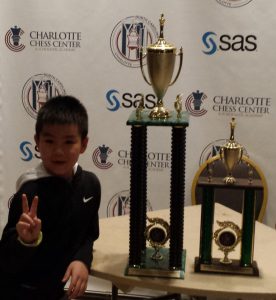 The elementary, middle and high school chess teams were just one example of teamwork at the 2015 NC K-12 Chess Championship held at the Hilton Charlotte University Place Feb 14th-15th. Even the youngest 2015 champion, K-1 champion Alfred Ye pictured here, wasn't born knowing the game -- it took a team of grown-ups, including his coach, Jeff "Pig" Jones of Pig Chess Services in Raleigh, to teach him the game, nurture his skills and provide him opportunities for excellence.
The elementary, middle and high school chess teams were just one example of teamwork at the 2015 NC K-12 Chess Championship held at the Hilton Charlotte University Place Feb 14th-15th. Even the youngest 2015 champion, K-1 champion Alfred Ye pictured here, wasn't born knowing the game -- it took a team of grown-ups, including his coach, Jeff "Pig" Jones of Pig Chess Services in Raleigh, to teach him the game, nurture his skills and provide him opportunities for excellence.
Organizing and promoting the competition
Providing a venue for any statewide sporting event requires a lot of teamwork, especially when the bulk of players are 2nd-5th graders filling up the 6,000+ square foot ballroom shown above. This year, the Charlotte Chess Center & Scholastic Academy (CCCSA) led 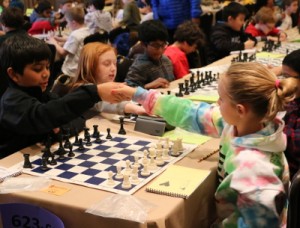 by Peter Giannatos organized and ran the North Carolina championship with the help of many volunteers.
by Peter Giannatos organized and ran the North Carolina championship with the help of many volunteers.
Publicizing the achievements of these young athletes of abstraction is yet another puzzle to be solved by smartphone-toting and web-wielding scholastic chess supporters. Unlike some professional, college and Olympic sporting events, this championship had no satellite trucks on the lawn nor mainstream media photo-journalists with neck-straps for their cameras. This year, ChessStream.com led the media charge by streaming the top games of the two-day championship live over the Internet for over 95,000 page views. (If you didn't catch the live action, you can still look at the archived games.)
And ChessStream's live coverage was just one part of the surge of web and social media attention around this year's championship:
- The North Carolina Chess Association (NCCA)
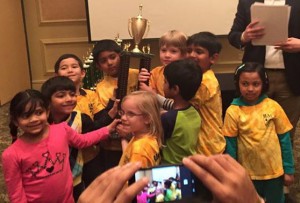
The champion K-1 team from Barringer Academic Center. congratulated the individual champions and posted pictures of several of them on its website.
- The Camel City Dispatch wrote an article about Atkins High School in Winston-Salem and Northern Vance High School in Henderson and covered the friendly rivalry between the two coaches, Scott Plaster and Johnny Williams.
- The CCCSA lauded the success of its championship players, especially the teams from Barringer Academic Center of Charlotte, which earned 1st place team finishes in the K-1 and K-3 sections and 3rd place in the K-5 section.
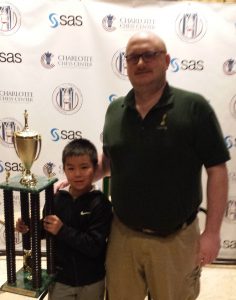
K-1 champion Alfred Ye and his coach Jeff "Pig" Jones. - The Triangle Math and Science Academy of Cary published a report of its successes on its website.
- Raleigh chess coach Jeff "Pig" Jones blogged about his players' experiences as well as his own on his chess.com blog.
- Social media saw the first uses of the #NCchess15 hashtag, which has been established for all of North Carolina's 2015 chess activities.
- ChessStream.com established a page of links for postings like the ones above -- check it for the latest content on the championship.
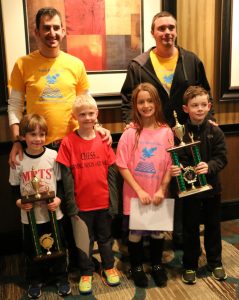
These weren't the only organizations at the championship marrying the centuries-old tradition of over-the-board chess tournaments with the Internet age. FIDE Master (FM) Mike Klein served as both a coach for ten Charlotte-area scholastic chess programs and as a representative of ChessKid.com where he is an online instructor going by "Fun Master Mike."
Chesskid.com is a unique and popular website that provides chess videos, articles, puzzles and online play against other kids. Chess coaches can even coach online and complement the over-the-board time at their scholastic chess clubs. Klein authored a post about using chesskid.com in his team room at the championship.
The magic of chess
But none of these supporting cast members would matter if it weren't for the young chess players and their enthusiasm for this Renaissance era game. As improbable as it may seem in a screen-infested world, the players are the real engines of scholastic chess growth -- especially the overwhelming plurality of elementary schoolers. They pursue competitive chess for the love of the game, and they get back benefits that will help them with STEM education and other pursuits. This is one example of the magic of chess, and for a lot of these players the magic started at a scholastic chess club at their school.
As players of chess at a young age, these students are in the same long-lived global club as Albert Einstein and many other luminaries in history. Einstein is believed to have played chess as a boy and was friends as an adult with Emanuel Lasker, the World Chess Champion from 1894 until 1921. While most serious scholastic tournament players have several recorded games and a chess rating, Einstein was never rated and only one of Einstein's purported games has survived: a 1933 contest with Robert Oppenheimer in Princeton, NJ.
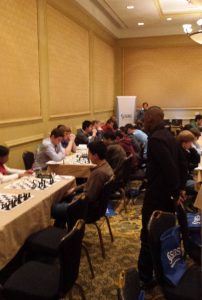
You can compare the Einstein vs. Oppenheimer contest to the recorded games from this championship. If you want, you could even estimate how good of a player Einstein was, and how well he would have fared at this championship, which included four National Masters (NMs):
- NM Aaron Balleisen
- NM Emmanuel Carter (see a recent article about Carter on TheChessDrum.net)
- NM Daniel Cremisi
- NM Tianqi Wang
The Masters competed in the top section, the K-12, for the top honors. Though technically open to any student from kindergarten through 12th grade, the K-12 section is the domain of advanced high school players. All of the sections except for K-1 played for two days with trophies awarded in the early evening, Sunday, Feb. 15th. Players played between 5 and 7 rounds, depending on section, with generous time controls. The K-1 section played only on Saturday, Feb. 14th and completed 6 rounds. For each game, players earned 1 point for a win, 1/2 point for a draw and 0 points for a loss. The top four individual scores for a team are summed to compute the team score.
And the winners are
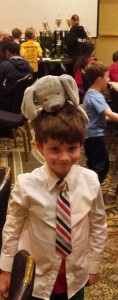
Congratulations to the NC champion teams for 2015:
- K-12: Myers Park High School, Charlotte, 13.0 of 20.0 points
- K-8: Randolph Middle School, Charlotte, 13.0 of 20.0 points
- K-12 rated under 1600: Durham Academy, Durham, 17.0 of 20.0 points
- K-8 rated under 1200: Davis Drive Middle School, Cary, 20.0 of 28.0 points
- K-5: Davis Drive Elementary School, Cary, 22.5 of 28.0 points
- K-3: Barringer Academic Center, Charlotte, 19.5 of 28.0 points
- K-1: Barringer Academic Center, Charlotte, 19.0 of 24.0 points
And the individual champions and co-champions:
- K-12: NM Tianqi Wang, 4.5 of 5.0 points
- K-8: Suhas Madiraju, Eelya Sefat, James Christopher Dill, Alexander Tong, Berk Ege Baykal, Matias Shundi and Andrew Bo-shine Chen, 4.0 points of 5.0 points
- K-12 rated under 1600: Carson Philip Cook, Leowell Bacudio, Judd Wilson Staples, and Christopher Chaves, 4.5 of 5.0 points
- K-8 rated under 1200: Audrey Zhou, 6.5 of 7.0 points
- K-5: Alex Chen, 7.0 of 7.0 points
- K-3: Vishnu Surya Vanapalli, 6.5 of 7.0 points
- K-1: Alfred Zhihua Ye, 6.0 of 6.0 points
Spread the magic
Want chess magic at your school? Start a chess club, help with an existing one or volunteer at a tournament! Here are some links to get you started:
- Read how an Oklahoma dad answered his own question: "could a parent with no expertise in chess start a chess club?" , Rockford Chess's primer on starting a chess club, and the United States Chess Federation's (USCF's) guide on starting a scholastic club.
- Interested in the research about the benefits of scholastic chess? Check out St. Louis Public Radio's article "On Chess: Literature Review Gives Base To Claim Of Chess' Educational Benefits."
- To prepare to propose a chess club to administrators and other parents, see my post, "Scholastic chess clubs: 10 reasons why" and this short TEDx talk, "How Chess Can Revolutionize Learning: Cody Pomeranz at TEDxYale."
Photos of K-1 team with NM instructors and of two chess players shaking hands by Christine VanCott of ChessKid.com.
